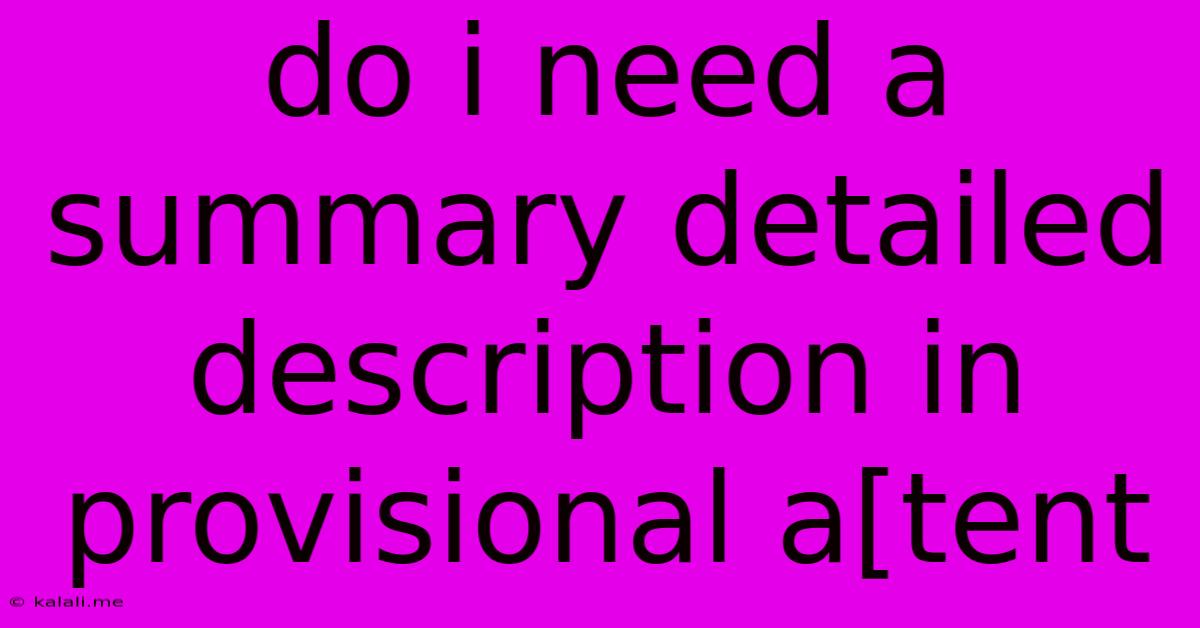Do I Need A Summary Detailed Description In Provisional A[tent
Kalali
Jun 02, 2025 · 3 min read

Table of Contents
Do I Need a Summary/Detailed Description in a Provisional Patent Application?
The question of whether you need a detailed description in a provisional patent application is a crucial one for inventors navigating the patent process. While a provisional application doesn't undergo the same rigorous examination as a non-provisional application, it's essential to understand what's required to effectively protect your invention and lay the groundwork for a stronger, future non-provisional application. This article clarifies the requirements and best practices.
Understanding Provisional Patent Applications: A provisional patent application is a less expensive and less demanding way to establish an early filing date for your invention. It provides a one-year grace period before you must file a full non-provisional application. However, this doesn't mean you can submit a haphazard document. While the requirements are less stringent, a well-crafted provisional application is paramount.
What the USPTO Requires: The "Written Description"
The United States Patent and Trademark Office (USPTO) requires a written description of your invention in your provisional application. This description doesn't need the same level of detail as a non-provisional application, but it must be sufficient to enable a person skilled in the art to make and use the invention. Think of it as a blueprint – enough information to construct the invention, albeit perhaps less precisely detailed than a final construction manual.
Key Elements of a Sufficient Written Description:
- Background of the Invention: Briefly describe the field of the invention and any existing technology related to it. This provides context.
- Summary of the Invention: A concise summary of your invention and its key features. This is a crucial element. While not strictly mandatory in the same way as the detailed description, a good summary improves readability and understanding for the examiner (and yourself later).
- Detailed Description of the Invention: This section forms the core of your provisional application. It should explain how your invention works, including:
- Detailed drawings or figures: Visual aids are often critical for clarifying complex inventions.
- Specific embodiments: Describe different ways your invention could be implemented.
- Claims (optional): While not strictly required, including draft claims can be beneficial in guiding the detailed description and highlighting the key inventive aspects. However, remember these aren't examined in the provisional stage.
- Enabling Disclosure: The most important aspect. Your description must be sufficiently detailed that someone skilled in the relevant technical area could reproduce your invention without undue experimentation. This is critical for the strength of your future non-provisional application.
Why a Well-Written Provisional Application Matters:
A well-written provisional application offers several advantages:
- Establishes Priority Date: This is the primary purpose – securing the earliest possible filing date for your invention.
- Provides a Foundation for the Non-Provisional Application: A strong provisional application significantly streamlines the process of filing a non-provisional application.
- Avoids Potential Problems: A poorly written provisional application can lead to issues later, such as challenges to your claim scope.
- Potential for Licensing or Investment: A well-documented provisional application can be attractive to potential licensees or investors.
In Conclusion:
While a provisional patent application doesn't demand the same level of meticulous detail as a non-provisional one, neglecting the written description is a significant mistake. A summary is helpful for clarity and context but the core requirement is a detailed enough description to enable someone skilled in the art to make and use the invention. Aim for a clear, concise, and enabling disclosure to establish your priority date effectively and pave the way for a successful non-provisional patent application. Consult with a patent attorney or agent for guidance specific to your invention.
Latest Posts
Latest Posts
-
Fallout 4 How To Scrap Junk
Jun 03, 2025
-
What Is The Charge For Iron
Jun 03, 2025
-
How To Fix A Cracked Porcelain Sink
Jun 03, 2025
-
How Do You Say A Play In Spanish
Jun 03, 2025
-
How Do You Say S In Spanish
Jun 03, 2025
Related Post
Thank you for visiting our website which covers about Do I Need A Summary Detailed Description In Provisional A[tent . We hope the information provided has been useful to you. Feel free to contact us if you have any questions or need further assistance. See you next time and don't miss to bookmark.